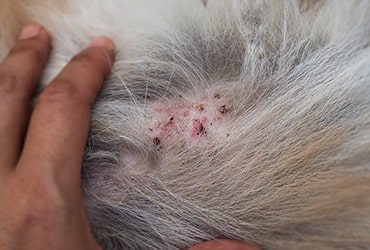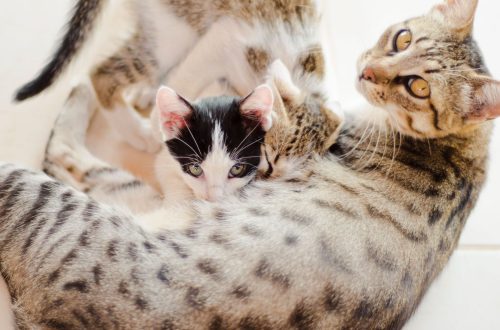
Blood in the urine of a cat or cat – what to do?

Contents
Blood in the urine in cats: the main thing
- Hematuria is a good reason to take your cat to the veterinarian.
- The main cause of blood in the urine of a cat or cat is diseases of the urinary and reproductive systems, as well as injuries.
- Frequent associated symptoms: frequent and painful urination, discharge, pain in the bladder area.
- Castration has little effect on the frequency of symptoms. Blood in the urine can be both in an ordinary cat and in a sterilized one.
- Diagnosis depends on the history, most often requiring a urinalysis and ultrasound.
- Treatment is complex and should be directed to the cause of the disease.
- If a cat or cat pees with blood, first aid can be provided at home, but you must first consult with your veterinarian.
- Prevention includes a balanced diet, drinking regimen, a high level of activity and timely castration / sterilization if the pet is not used for breeding.

Causes of blood in the urine of cats
If a cat or a cat goes to the toilet with blood, this may indicate the following diseases:
- Urocystitis (inflammation of the bladder);
- Urolithiasis disease;
- Inflammatory diseases of the kidneys;
- Injuries (fall, blow, operation);
- Prostate diseases in males (prostatitis, hyperplasia);
- Balanoposthitis – inflammation of the penis;
- Orchitis – inflammation of the testes;
- Diseases of the reproductive system in females (endometritis, vaginitis, ovarian cysts, etc.).
Concomitant symptoms
With different pathologies, different accompanying symptoms will appear.
So, for urocystitis and ICD it is characteristic:
- Pollakiuria (frequent urination);
- Periuria (uncleanliness);
- Excessive licking of the groin;
- Prolonged stay in the tray.
With urolithiasis, in addition to the fact that the cat pees with blood, there is a periodic inability to urinate (blockage of the urethra).
For inflammation of the kidneys:
- General malaise, lethargy;
- Fever;
- Decreased appetite;
- Acute soreness of the entire abdominal wall;
- Prolonged, painful urination;
- Cloudy or pink urine.
In case of injury:
- Acute soreness of the tissues at the site of impact;
- Hematomas, abrasions.
Prostate diseases are characterized by:
- Painful, prolonged urination;
- Change in posture when urinating;
- uncleanliness;
- Discharge from prepuce;
- inability to urinate;
- It is much more common in uncastrated animals.
With diseases of the reproductive system in a cat, blood in the urine can appear for two reasons. First, inflammation of the uterus or vagina can cause inflammation of the bladder (urocystitis). After all, the urethral canal is in close contact with the vagina. Secondly, vaginal discharge (with blood) can get into the urine already outside when the cat pees.
Symptoms:
- Violation of the sexual cycle, frequent estrus;
- Vaginal discharge;
- Excessive licking of the groin;
- increased thirst;
- Fever;
- Increase in the volume of the abdomen;
- Lethargy, drowsiness;
- Decreased appetite;
- Mastitis (inflammation of the mammary glands).
Balanoposthitis in a cat, in addition to hematuria, manifests itself:
- Hyperemia (redness) of the penis;
- Excessive licking of the inguinal region;
- Discharge from the prepuce;
- Prolonged, painful urination.
Orchitis can only be in uncastrated males. The urethra connects to the vas deferens, respectively, if there is blood in the semen, then from time to time it will appear in the cat’s urine.
Typical for orchitis:
- Swelling and soreness of the testis/testes;
- Sexually active cats are affected;
- The frequency of urination may not change.
Features in neutered cats
If the cat is castrated, then with a high degree of probability we can exclude such diagnoses as prostatitis, orchitis. It was previously thought that neutered cats were more likely to suffer from MCD. However, statistics refute this fact. But why are neutered cats considered more at risk?
The main reason is mobility. Testosterone, which is mostly produced by the testes, is no longer supplied in the same amounts, which leads to changes in metabolism. No, the cat will not become a “vegetable” after castration, because the hunting instinct will not go anywhere, but it will move a little less, and the appetite – with a high probability – will increase. Reduced activity and overeating leads to weight gain, and further to the formation of sand and stones.
Diagnostics
For the diagnosis of urocystitis and KSD, you will need:
- General urine analysis;
- Bladder ultrasound;
- LHC urine culture (not always);
- X-ray of the abdominal cavity (if ICD is suspected).
For inflammation of the kidneys:
- Urinalysis and urine protein/creatinine ratio;
- Biochemistry of blood;
- Ultrasound of the urinary system;
- LHC urine culture (not always).
For injuries:
- Ultrasound of the abdominal cavity;
- X-ray of the abdominal cavity;
- Clinical blood test.
For diseases of the prostate gland and orchitis:
- General urine analysis;
- Ultrasound of the genitourinary system;
- LHC urine culture (not always).
For diseases of the reproductive system in females:
- Ultrasound of the genitourinary system;
- General urine analysis.
With balanoposthitis:
- General urine analysis;
- Deep smear cytology;
- Ultrasound of the genitourinary system;
- BAC sowing (not always).

Hematuria treatment
For the treatment of urocystitis, KSD, nephritis, the following measures and groups of drugs are used:
- Antispasmodics;
- Pain relievers;
- Plentiful drink;
- Antibiotics (not always).
With KSD, specialized diets and drugs that affect urine pH are additionally used.
In nephritis, intravenous infusions and several groups of antimicrobials can be used simultaneously.
If a cat pees with blood after an injury, you will need:
- Restriction of mobility;
- Pain relievers;
- Hemostatic;
- Surgery may be required (for example, if the wall is torn).
For diseases of the reproductive system in cats and cats, the following are used:
- Pain relievers;
- Antispasmodics;
- In males, antihypertensive drugs that relax the urethra;
- antibiotics;
- Operation (castration).

If an operative visit to the veterinarian is not possible
If a cat or a cat pees with blood, the first thing to do is to ensure that the pet is calm. Arrange a bed for him in a quiet warm place, surround him with care. Keep several bowls of fresh water near your pet.
In no case should you give drugs from a human first-aid kit without a doctor’s recommendation. First, many drugs cannot be used in animals. Secondly, dosages in cats and people are completely different. Thirdly, many drugs have contraindications for use.
To properly provide first aid to your pet while you can’t get him to the clinic, you can consult with a veterinarian online in the Petstory mobile app. The doctor will collect a detailed history, recommend how to help the pet at the moment, tell you what diagnostics should be done and what could be the reason for the appearance of red urine in your cat. You can download the application from the link.
Prevention of hematuria
First of all, you should pay attention to the diet, exercise and drinking regimen. The fact is that cats are not always thirsty, even if they are actually dehydrated.
It is required to arrange several bowls of water in different places in the apartment.
Another important factor is diet. With an excess of certain microelements (crystal-forming substances), the risks of sedimentation in the urine and, as a result, urolithiasis increase.
It is important to actively play with the cat. In nature, they are constantly moving, they need to hunt a lot in order to get their own food. But in the apartment, the cat does not realize even half of its energy resources, which provokes the deposition of sediment in the bladder.
Attention should be paid to the health of the reproductive system. If you do not plan to have kittens, then it is better to castrate / sterilize the pet. If you still want your pet to leave offspring, then once a year it is necessary to undergo a preventive examination of the reproductive system.
July 19 2021
Updated: July 20, 2021





